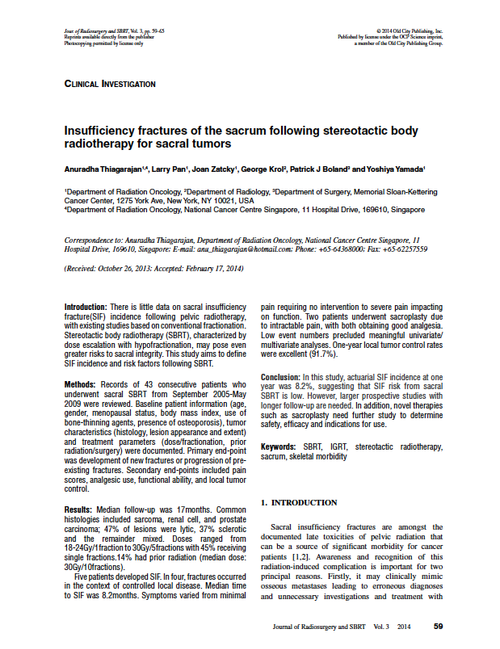- Home
- Journal Contents Downloads
- JRSBRT Downloads
- JRSBRT 3.1, p. 59-65
Product Description
Insufficiency fractures of the sacrum following stereotactic body radiotherapy for sacral tumors
Anuradha Thiagarajan, Larry Pan, Joan Zatcky, George Krol, Patrick J. Boland and Yoshiya Yamada
Introduction: There is little data on sacral insufficiency fracture (SIF) incidence following pelvic radiotherapy, with existing studies based on conventional fractionation. Stereotactic body radiotherapy (SBRT), characterized by dose escalation with hypofractionation, may pose even greater risks to sacral integrity. This study aims to define SIF incidence and risk factors following SBRT.
Methods: Records of 43 consecutive patients who underwent sacral SBRT from September 2005-May 2009 were reviewed. Baseline patient information (age, gender, menopausal status, body mass index, use of bone-thinning agents, presence of osteoporosis), tumor characteristics (histology, lesion appearance and extent) and treatment parameters (dose/fractionation, prior radiation/surgery) were documented. Primary end-point was development of new fractures or progression of preexisting fractures. Secondary end-points included pain scores, analgesic use, functional ability, and local tumor control.
Results: Median follow-up was 17months. Common histologies included sarcoma, renal cell, and prostate carcinoma; 47% of lesions were lytic, 37% sclerotic and the remainder mixed. Doses ranged from 18-24Gy/1fraction to 30Gy/5fractions with 45% receiving single fractions.14% had prior radiation (median dose: 30Gy/10fractions).
Five patients developed SIF. In four, fractures occurred in the context of controlled local disease. Median time to SIF was 8.2months. Symptoms varied from minimal pain requiring no intervention to severe pain impacting on function. Two patients underwent sacroplasty due to intractable pain, with both obtaining good analgesia. Low event numbers precluded meaningful univariate/multivariate analyses. One-year local tumor control rates were excellent (91.7%).
Conclusion: In this study, actuarial SIF incidence at one year was 8.2%, suggesting that SIF risk from sacral SBRT is low. However, larger prospective studies with longer follow-up are needed. In addition, novel therapies such as sacroplasty need further study to determine safety, efficacy and indications for use.
Keywords: SBRT, IGRT, stereotactic radiotherapy, sacrum, skeletal morbidity
After payment has been processed for your order of a digital copy (PDF) of this article, you will see a download link on your completed order page and also receive an email containing a download link. The links, which will enable you to download one copy of the article, will expire after 24 hours.
 Loading... Please wait...
Loading... Please wait...



